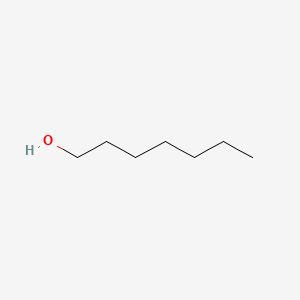| MeSH term | MeSH ID | Detail |
|---|---|---|
| Eye Burns | D005126 | 13 associated lipids |
| Ventricular Dysfunction, Left | D018487 | 33 associated lipids |
| Tachycardia, Ventricular | D017180 | 9 associated lipids |
| Heart Injuries | D006335 | 6 associated lipids |
| Wounds, Gunshot | D014948 | 2 associated lipids |
| Tachycardia, Ectopic Atrial | D013612 | 1 associated lipids |
n-heptanol
N-heptanol is a lipid of Fatty Acyls (FA) class. N-heptanol is associated with abnormalities such as Corneal Neovascularization. N-heptanol often locates in Epithelium and Structure of corneal epithelium. The related lipids are Heptanol.
Cross Reference
Introduction
To understand associated biological information of n-heptanol, we collected biological information of abnormalities, associated pathways, cellular/molecular locations, biological functions, related genes/proteins, lipids and common seen animal/experimental models with organized paragraphs from literatures.
What diseases are associated with n-heptanol?
n-heptanol is suspected in Corneal Neovascularization and other diseases in descending order of the highest number of associated sentences.
Related references are mostly published in these journals:
| Disease | Cross reference | Weighted score | Related literature |
|---|
Possible diseases from mapped MeSH terms on references
We collected disease MeSH terms mapped to the references associated with n-heptanol
PubChem Associated disorders and diseases
What pathways are associated with n-heptanol
There are no associated biomedical information in the current reference collection.
PubChem Biomolecular Interactions and Pathways
Link to PubChem Biomolecular Interactions and PathwaysWhat cellular locations are associated with n-heptanol?
Visualization in cellular structure
Associated locations are in red color. Not associated locations are in black.
Related references are published most in these journals:
| Location | Cross reference | Weighted score | Related literatures |
|---|
What functions are associated with n-heptanol?
There are no associated biomedical information in the current reference collection.
What lipids are associated with n-heptanol?
Related references are published most in these journals:
| Lipid concept | Cross reference | Weighted score | Related literatures |
|---|
What genes are associated with n-heptanol?
There are no associated biomedical information in the current reference collection.
What common seen animal models are associated with n-heptanol?
There are no associated biomedical information in the current reference collection.
NCBI Entrez Crosslinks
All references with n-heptanol
Download all related citations| Authors | Title | Published | Journal | PubMed Link |
|---|---|---|---|---|
| pmid: | ||||
| Venkateswarlu K et al. | Effects of heptanol on the neurogenic and myogenic contractions of the guinea-pig vas deferens. | 1999 | Br. J. Pharmacol. | pmid:10051140 |
| Skogvall S and Grampp W | Physiological oxygen concentration gives an oscillating spontaneous tone in guinea-pig tracheal preparations. | 1999 | Acta Physiol. Scand. | pmid:10072101 |
| Tarner IH et al. | Heptanol exerts epileptiform effects in identified neurons of the buccal ganglia of Helix pomatia. | 1999 | Neurosci. Lett. | pmid:10320017 |
| Christ GJ et al. | Further evidence for the selective disruption of intercellular communication by heptanol. | 1999 | Am. J. Physiol. | pmid:10362670 |
| Manchanda R and Venkateswarlu K | Quantal evoked depolarizations underlying the excitatory junction potential of the guinea-pig isolated vas deferens. | 1999 | J. Physiol. (Lond.) | pmid:10523420 |
| Lu C et al. | Electrical coupling of retinal horizontal cells mediated by distinct voltage-independent junctions. | 1999 Sep-Oct | Vis. Neurosci. | pmid:10580717 |
| Scemes E et al. | Intercellular communication in spinal cord astrocytes: fine tuning between gap junctions and P2 nucleotide receptors in calcium wave propagation. | 2000 | J. Neurosci. | pmid:10662834 |
| Hau KM et al. | Use of partition models in setting health guidelines for volatile organic compounds. | 2000 | Regul. Toxicol. Pharmacol. | pmid:10715221 |
| Mori T et al. | Roles of gap junctional communication of cumulus cells in cytoplasmic maturation of porcine oocytes cultured in vitro. | 2000 | Biol. Reprod. | pmid:10727260 |
| Karvonen SL et al. | Psoriasis and altered calcium metabolism: downregulated capacitative calcium influx and defective calcium-mediated cell signaling in cultured psoriatic keratinocytes. | 2000 | J. Invest. Dermatol. | pmid:10733675 |
| Burgalassi S et al. | Effect of xyloglucan (tamarind seed polysaccharide) on conjunctival cell adhesion to laminin and on corneal epithelium wound healing. | 2000 Jan-Mar | Eur J Ophthalmol | pmid:10744209 |
| Kuebler WM et al. | A novel signaling mechanism between gas and blood compartments of the lung. | 2000 | J. Clin. Invest. | pmid:10749570 |
| Christ GJ and Brink PR | Gap junctions in isolated rat aorta: evidence for contractile responses that exhibit a differential dependence on intercellular communication. | 2000 | Braz. J. Med. Biol. Res. | pmid:10775307 |
| Jiang YB and Jin MG | Intramolecular charge transfer at reverse micelle-water pool interface: p-N,N-dimethylaminobenzoic acid in AOT/cyclohexane/water reverse micelle. | 2000 | Spectrochim Acta A Mol Biomol Spectrosc | pmid:10794439 |
| Ilvesaro J et al. | Bone-resorbing osteoclasts contain gap-junctional connexin-43. | 2000 | J. Bone Miner. Res. | pmid:10804022 |
| Saint-Amant L and Drapeau P | Motoneuron activity patterns related to the earliest behavior of the zebrafish embryo. | 2000 | J. Neurosci. | pmid:10818131 |
| Mire P et al. | Gap junctional communication in the vibration-sensitive response of sea anemones. | 2000 | Hear. Res. | pmid:10831870 |
| Vaidya P et al. | Analysis of synaptic quantal depolarizations in smooth muscle using the wavelet transform. | 2000 | IEEE Trans Biomed Eng | pmid:10833844 |
| Do CW and To CH | Chloride secretion by bovine ciliary epithelium: a model of aqueous humor formation. | 2000 | Invest. Ophthalmol. Vis. Sci. | pmid:10845609 |
